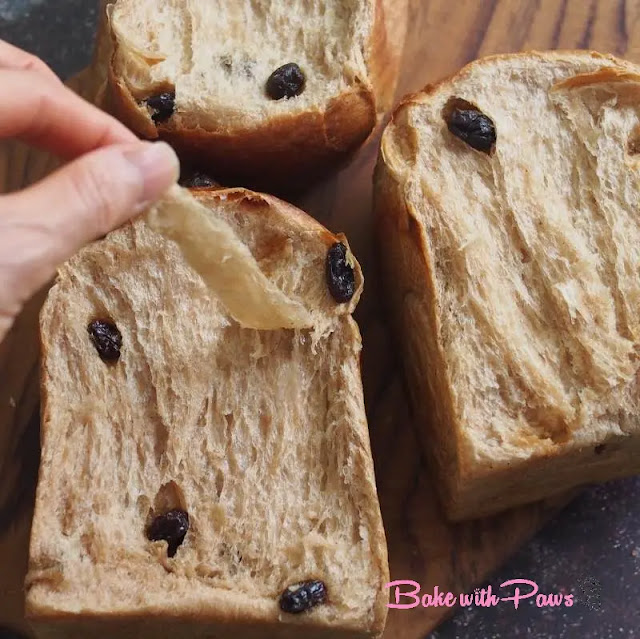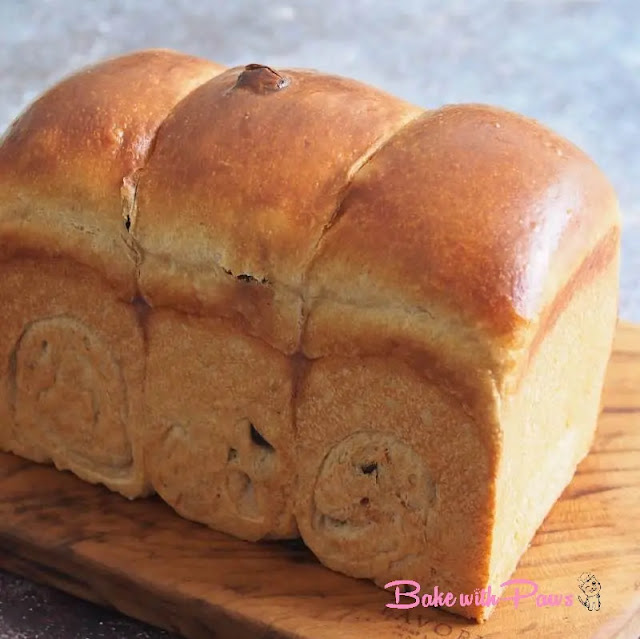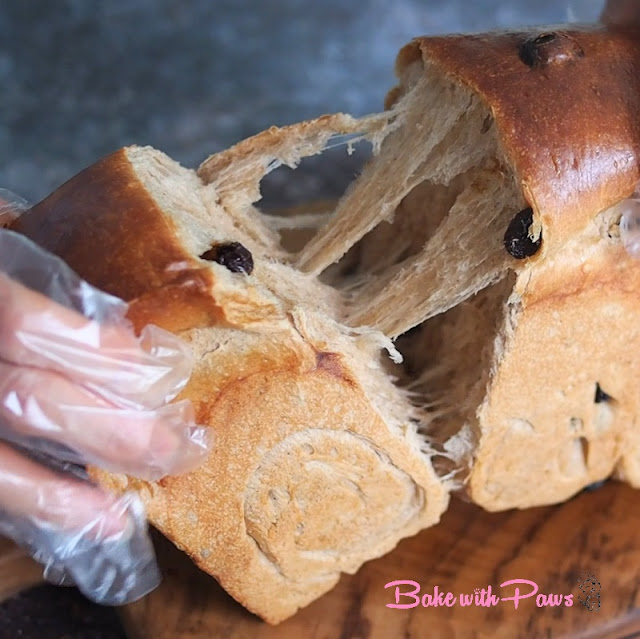The aroma in my kitchen was just heavenly when I baked this Cinnamon Raisin Soft Sourdough Bread. This bread is so delicious and you can eat it on its own. I think this is going to be a perfect bread for the Christmas bread basket.
The bread texture is soft, moist, fluffy and slightly chewy. As it is made using the Yudan method, it also stays fresh longer.
An advantage of using the Yudane method is that the bread stays fresh much longer. Please click "Bread Making Method" to understand more details on Yudane Method.
If you have any questions regarding this recipe or any other post, please leave me a comment in the “LEAVE A COMMENT” link and I will reply you as soon as possible. Do tag me on Instagram @Bakewithpaws if you attempt on this recipe.
RECIPE - CINNAMON RAISIN SOFT SOURDOUGH BREAD
Yields: 1 loaf
Utensil: 450g loaf pan (21.3 X 12.2 X 11.5 cm / 8.4" X 4.8" X 4.5")
INGREDIENTS:
Yudane Dough:
65g bread flour (I used Japan High Gluten Flour)
65g boiling water
Sweet Stiff Starter:
56g sourdough starter (100% Hydration), use at its peak to get better result. *
172g bread flour (I used Japan High Gluten Flour)
72g water
28g sugar (I used organic light brown sugar)
Main Dough:
65g bread flour (I used Japan High Gluten Flour)
All yudane dough (above)
All stiff starter (above)
10g light brown sugar (I used organic brown sugar)
1 tsp salt (5.7g)
3 tsp (8g) ground cinnamon
45g egg, whisked (from 1 medium egg), balance use for egg wash
35 whipping cream or 20g water (I used whipping cream)
30g butter, room temperature
60g black raisins, rinse with hot water and let them dry on a kitchen paper towel.
Egg Wash: (Optional)
Balance of whisked egg from the above + 1/2 tsp water
* Sometimes I used young sourdough discard and it works too. It is very much depend on your starter.
METHOD:
- Yudane
- Add bread flour in a bowl, pour the boiling water and mix well with spatula or spoon until no dry flour.
- Cover and rest for at least 4 hours or overnight in the fridge. I prepared the night before.
- Take out from the fridge 30 minutes before using to return to room temperature.
- Sweet Stiff Starter
- In a bowl of stand mixer, dilute starter with water, stir in sugar and add in bread flour. Mix with paddle attachment until well mixed and all come together. It can be done by hand mixing too.
- Cover and let it ferment until tripled. I prepared a night before and leave it in aircond room (approximately 24 - 25C room temperature) overnight until tripled. It took about 8 - 9 hours depending on your starter. It should take around 4 - 6 hours to get triple at room temperature at 28C - 30C. The starter should look smooth and round dome. It shouldn't collapse.
- Main Dough:
- Put all ingredients (except butter) into a bowl of stand mixer. I usually torn the stiff starter and yudane dough slightly first.
- Slightly combine the mixture by hand with the paddle attachment before turning on the machine so that the flour will not splash out. Using the paddle attachment, mix at low speed #2 for about a minute or until all incorporated. This step is critical to prevent an uneven mixed dough as the stiff starter is rather hard and a dough hook may not be able to mix it well enough.
- Change to hook attachment and knead for another 3 minutes at low speed #2 (KA) or until the dough comes together. Add in butter and continue knead for 10 minutes at low speed #2 or until reach window pane stage. The whole kneading process, I stopped few times to scrape down the dough from the hook to be sure it is evenly kneaded and also to prevent the motor from overheating.
- Add in raisin and continue kneading for about 1 -2 minute until the raisins evenly mix in the dough.
- 1st Proofing/Resting:
- In the same bowl, let the dough rest for 30 - 60 minutes. Keep it covered with clingfilm or use a lid. This dough I rested for 45 minutes at 29C - 30C room temperature and the dough rose slightly in 45 minutes. (I did not find any big differences of 30 mins to 60 minutes rest. So, please follow your schedule).
- Shaping:
- Transfer the dough to a clean floured or slightly oiled surface then divide into 2 or 3 equal portions. Please use a kitchen scale if you want to be exact.
- Form each portion to a ball. Flatten with rolling pin.
- Fold right to centre and fold left overlap it. Roll out with rolling pin into long rectangle shape. Roll up the dough like Swiss Roll until a small log is formed.
- Place all dough in the prepared loaf pan.
- Final Proofing :
- Let it proof in a warm place until the dough reaches about 1 cm below the height of the pan. This one took approximately 3 hours at room temperature of 29C - 30C. The duration of proofing depends on your ambient temperature and starter.
- Baking:
- Preheat oven at 180C - 200C (top & bottom heat) for 15 minutes.
- Brush with egg wash (optional) and bake in a preheated oven for about 30 - 35 minutes, or until golden brown.
- Remove bread from oven and let them cool on rack completely before slicing.
GENERAL NOTES:
SOURDOUGH STARTER
A healthy starter is very crucial as advised by Baking with Gina. It is advisable to feed your starter regularly if you want your bread to rise nicely and to use the starter (levain) at its peak. A starter that is fed regularly will be more active in general. If the mother starter is not strong, the bread dough will not rise a lot even though the starter is used at its peak.
There are so many ways and methods of how to maintain the starter. Below is my method of starter maintenance. This is just for your reference. Please try and find a way or schedule that works best for you.
I bake almost everyday. So, my starter is left at room temperature and I feed it twice a day every 12 hours at its peak when it is tripled.
Example
10.00 am - at ratio 1:10:10 at room temperature 26C - 27C
10.00 pm - at ratio 1:10:10 at room temperature 25C - 26C
I feed a very small amount of 1g starter + 10g water + 10g flour if I am not baking, so that I will not end up with too much discard. When I am baking, I will feed the starter accordingly to make up the quantity required by the recipe to be baked. If I know that I won't be baking for a few days, I will then feed it only once a day at 1:10:10, transfer to the fridge when it is doubled, and feed again 24 hours later.
If you do not bake daily or if you bake perhaps once or twice a week, then you may place your starter in the fridge and feed once a week. But, you will need to refresh your starter 2 days before the baking day. There is no way around this, sourdough baking takes planning!
How I judge my starter is healthy? My starter usually tripled in size (or at least double) in within 3 - 4 hours at room temperature (27C - 28C) for feeding ratio of (1:1:1 = starter:water:flour)
When is a starter at its peak? My sourdough starter is usually at its peak when it is tripled in the jar. The surface of my starter looks bubbling and uneven. It usually stays at its peak within 30 - 60 minutes before it starts to reduce/fall.
Why use starter at its peak? This is when the starter is most active and it will result in a better rise for your bread in general. By the way, you can use when it is doubled/before its peak too. But, not it starts to fall.
GLUTEN DEVELOPMENT & WINDOWPANE TEST
Gluten forms when flour comes in contact with water. Hydration of the flour causes the sticky and stretchy protein to form, giving structure to the bread. This makes your bread trap air and rise.
Gluten in dough can be developed by autolyse, resting, kneading or folding.
The windowpane test is used to determine whether the dough has been sufficiently kneaded. By gently pulling the dough (or you may pinch off some dough) and trying to stretch it into a thin membrane. If you are able to stretch the dough paper thin and translucent without tearing, then the gluten is fully developed. However, if you can stretch it without tearing but the membrane is not transparent, then the gluten is not yet fully developed.
However, from my experience not all the recipe can achieve a thin and translucent window pane stage easily. For example low hydration and low fat dough. For such recipes, a reasonable window pane is good enough and it can be left to rest. Gluten will continue to develop while resting. Exercising restraint to not over-knead the dough prevents the gluten from being overworked and broken. Some of you may have experienced the dough breaking during the second proofing. It is because the dough is over kneaded.
The total kneading time for me is usually 15 minutes at low speeds except brioche dough with high fat percentage or dough using liquid fat which usually takes a little longer (maybe 18-20 mins).
From my experience, I found that high hydration dough with high percentage of fat will be easy to stretch and achieve a paper thin windowpane stage.
MILK POWDER
Why do I use milk powder?
- Milk or milk powder will enhance the flavour of the bread and makes the bread texture softer due to the fat content of the milk.
- Milk powder is shelf stable and you can have it anytime when you want to use. Unlike liquid milk you need to finish within a certain time before it spoils.
For kneading, please regard the timing provided as an indication only. It is only meant as a guide. Timing may differ depending on the brand of flour and electric mixer used. The protein content may vary from one brand of flour to another.
FLOUR
The right flour plays a very important role in bread making. To achieve fluffy, soft and light bread, I used Japan High Gluten Flour in most of my bread baking. The protein content is around 12 - 13%.
HYDRATION
The liquid measurement given is also a guide. It is advisable to always reserve some liquid and not add it all in one go. This would give you the opportunity to adjust if necessary. If dough is too dry, add the reserve liquid one tablespoon at a time until the right consistency. This is because each flour absorbs water and hydrates differently.
PROOFING
Please note that the proofing timing may also vary depending on your climate, environment, flour and your starter.
If you are unable to judge by just looking at the dough, you can do the finger poke test:
Proofing:
- Lightly press the side of the proved dough with your finger. If it bounces back immediately without any indentation, it means the dough is under proved and needs more time before baking.
- If the indentation stays and it doesn’t bounce back, it means it has been over proved.
- If the indentation slowly bounces back and leave a small indentation, it is ready to bake.
- There will be a final burst of rising once the bread is placed to bake in the oven and it is called oven spring.
If your bread collapses or gets wrinkled on top after removing from oven, it could be because your dough over proved during the second proofing. Please proof until the tip of the dough just reaches the rim of the pan, around 80% - 90% in size.
BAKING TEMPERATURE AND TIME
Do also note that the baking temperature and timing provided are what works for my oven and should also be regarded as a guide only. Every oven behaves a little differently, so please adjust accordingly for your oven.



